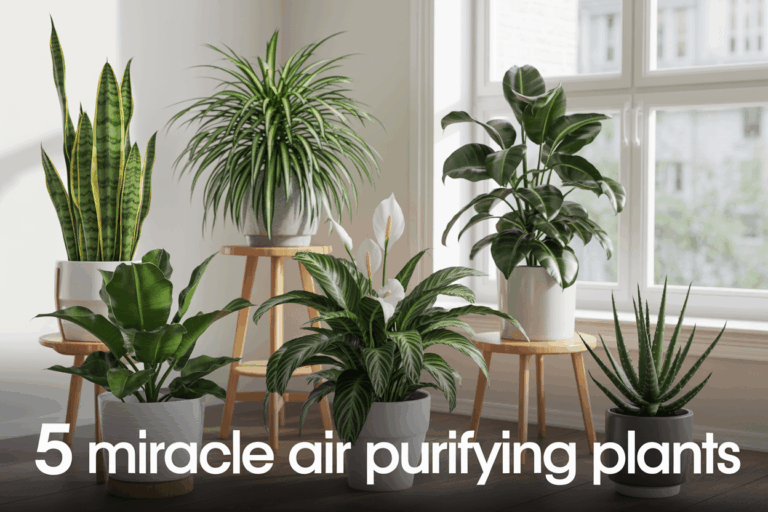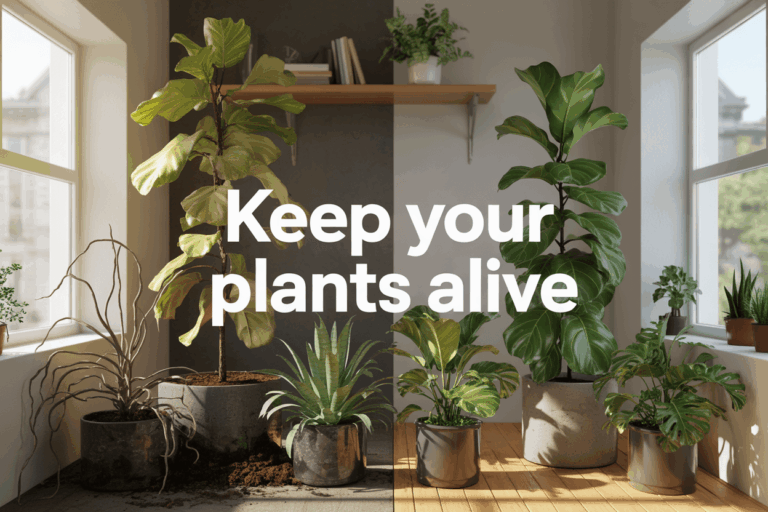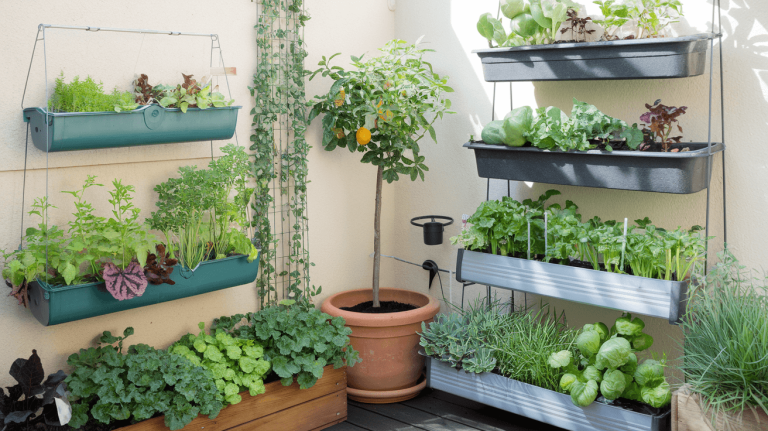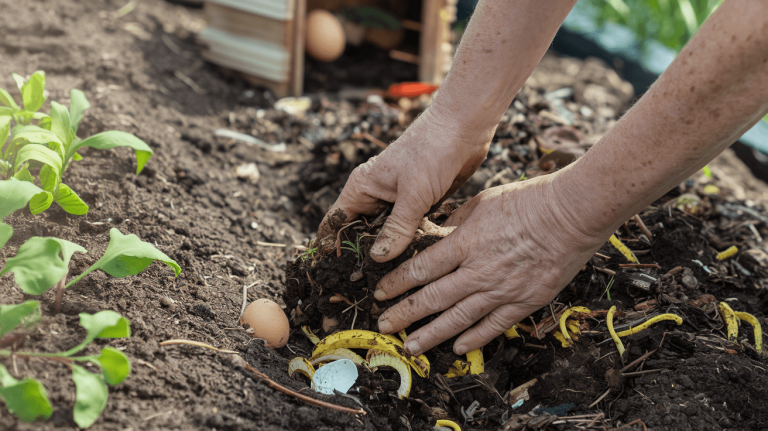Hydroponic Gardening at home: Why Soil Might Be Overrated
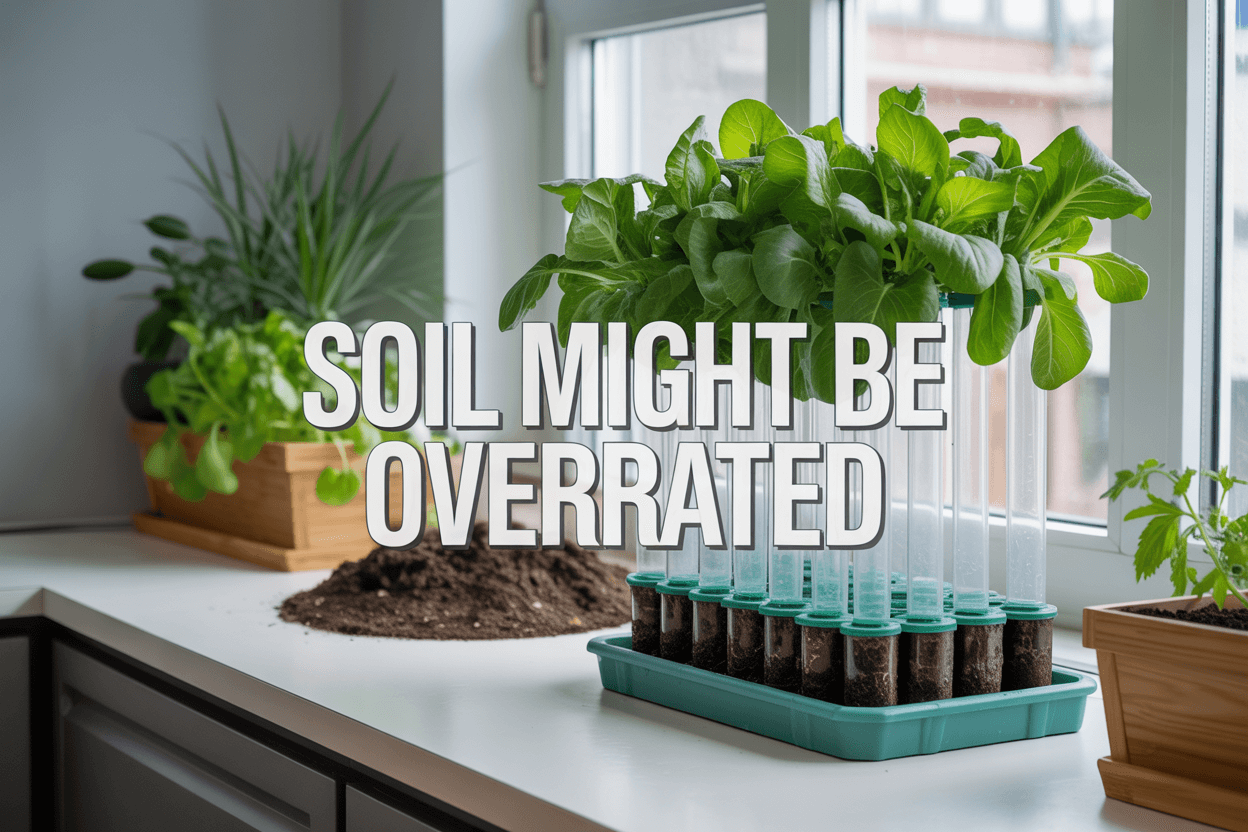
Hydroponic gardening at home is changing how people grow fresh food without ever touching dirt. This guide is for curious beginners, apartment dwellers with limited space, and eco-conscious gardeners ready to try something new.
You’ll discover why plants actually grow faster and healthier when their roots skip soil entirely. We’ll break down the real costs versus long-term savings, so you know exactly what you’re getting into financially. Plus, you’ll learn which plants thrive best in hydroponic systems and how to avoid the most common beginner mistakes.
Get ready to rethink everything you thought you knew about growing food at home.
Understanding Hydroponic Gardening Fundamentals
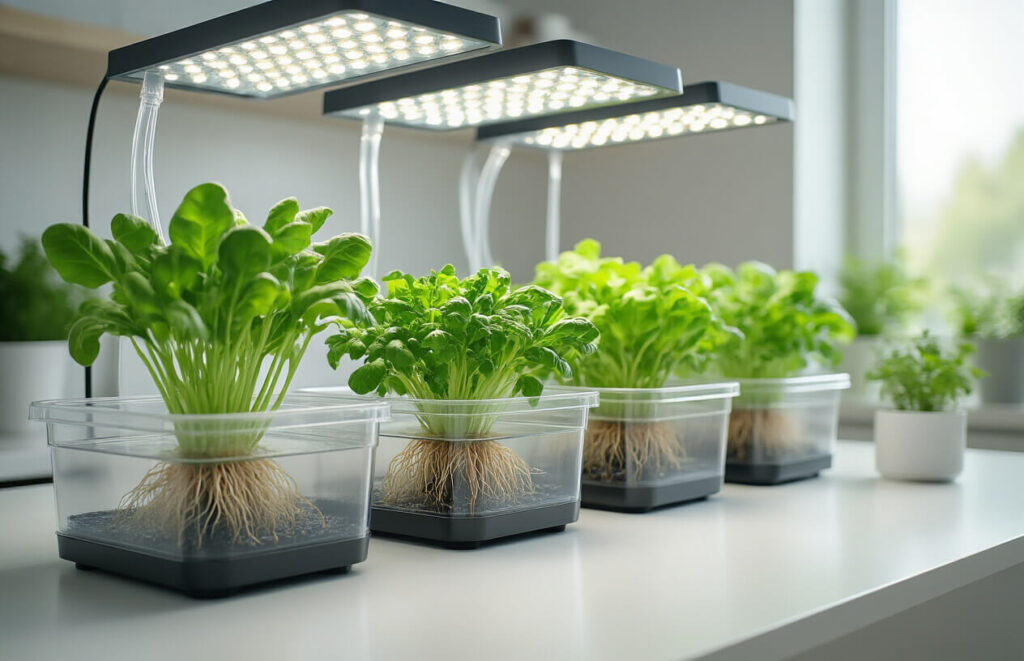
Water-based nutrient delivery systems explained
Traditional soil acts as a storage medium for nutrients, but hydroponic gardening eliminates this middleman entirely. Instead of roots searching through soil for food, plants receive their nutrition directly through a carefully balanced water solution. This nutrient-rich water contains all the essential elements plants need – nitrogen, phosphorus, potassium, calcium, magnesium, and trace minerals – in precise concentrations.
The magic happens when these dissolved nutrients make direct contact with plant roots. Without soil barriers, plants absorb nutrients more efficiently, leading to faster growth rates and often better yields. Think of it like giving your plants an IV drip of perfectly balanced food rather than forcing them to forage through dirt.
Different systems deliver these nutrients in various ways. Some continuously circulate nutrient solution past the roots, while others use timed feeding cycles. The key is maintaining the right pH level (typically 5.5-6.5) and nutrient concentration to keep plants thriving.
Essential equipment needed to start your home setup
Getting started with hydroponic gardening doesn’t require breaking the bank. Your basic equipment list includes a reservoir tank to hold your nutrient solution, an air pump and air stone to oxygenate the water, and a reliable pH testing kit or digital meter.
You’ll also need growing containers or net pots, a growing medium like expanded clay pebbles or rockwool, and a quality hydroponic nutrient solution. A simple timer helps automate feeding cycles, while basic grow lights become essential if you’re growing indoors or in low-light areas.
| Essential Item | Purpose | Approximate Cost |
|---|---|---|
| Reservoir Tank | Holds nutrient solution | $15-50 |
| Air Pump & Stone | Oxygenates water | $10-25 |
| pH Test Kit | Monitors water chemistry | $5-30 |
| Growing Medium | Supports plant roots | $10-20 |
| Net Pots | Holds plants and medium | $5-15 |
| Nutrient Solution | Feeds plants | $15-40 |
Many beginners start with all-in-one kits that bundle these components together, making the initial setup process much simpler.
Popular hydroponic methods for beginners
Deep Water Culture (DWC) stands out as the most beginner-friendly method. Plants sit in net pots suspended over a reservoir of oxygenated nutrient solution, with roots dangling directly into the water. This system requires minimal maintenance once established and works wonderfully for leafy greens and herbs.
The Kratky method offers an even simpler passive approach. Plants start with their roots touching the nutrient solution, but as they grow and consume water, an air gap develops naturally. This eliminates the need for pumps or electricity, making it perfect for absolute beginners.
Ebb and flow systems periodically flood growing beds with nutrient solution before draining back to the reservoir. This method works well for various plant sizes and provides excellent root aeration between flooding cycles.
Nutrient Film Technique (NFT) uses sloped channels where a thin film of nutrient solution continuously flows past plant roots. While slightly more complex, NFT systems use water efficiently and work great for smaller plants like lettuce and strawberries.
Space requirements and setup considerations
Hydroponic systems adapt remarkably well to different spaces. A simple countertop setup can support herbs and small greens in just a few square feet, while larger operations might claim an entire room or basement area.
Vertical growing maximizes space efficiency, allowing you to stack multiple growing levels. A 4×4 foot area can easily accommodate 16-32 plants when using vertical techniques, compared to just 4-9 plants in traditional horizontal arrangements.
Consider your available light when choosing locations. South-facing windows provide excellent natural light, but most indoor setups benefit from supplemental LED grow lights. These lights should hang 12-24 inches above plants, depending on their intensity.
Water access matters more than you might expect. Regular reservoir changes and top-offs become much easier when you’re near a water source. Electrical outlets are essential for pumps, lights, and timers, so plan your setup accordingly.
Temperature stability helps plants thrive. Most vegetables prefer temperatures between 65-75°F, so avoid areas with extreme temperature swings like unheated garages or sunny windowsills. Good ventilation prevents humidity buildup and strengthens plant stems through gentle air movement.
Superior Growth Performance Over Traditional Soil

Faster plant growth rates and shorter harvest cycles
Plants in hydroponic systems consistently outpace their soil-grown counterparts by 25-50% in growth speed. When roots don’t need to search through soil for nutrients, they can focus their energy entirely on growth and development. This direct nutrient delivery system means lettuce that typically takes 8-12 weeks in soil can be ready for harvest in just 4-6 weeks with hydroponic gardening.
The science behind this acceleration lies in the plant’s ability to absorb nutrients immediately. In soil, plants spend considerable energy developing extensive root systems to hunt for water and nutrients. Hydroponic systems eliminate this energy expenditure, redirecting that power toward leaf, fruit, and vegetable production.
Increased yield potential in smaller spaces
Space efficiency becomes remarkable when you remove soil from the equation. Vertical hydroponic towers can produce 10 times more vegetables per square foot than traditional gardens. A single 4×4 foot hydroponic setup can yield the same amount of produce as a 40×40 foot soil garden.
Root systems in hydroponic gardening remain compact since nutrients are readily available, allowing plants to be spaced closer together without competition. Cherry tomatoes that need 3 feet between plants in soil gardens can thrive with just 18 inches of spacing in hydroponic systems.
Year-round growing capabilities regardless of season
Indoor hydroponic systems break free from seasonal limitations entirely. While outdoor soil gardens lie dormant through winter months, hydroponic setups maintain consistent production cycles. LED grow lights combined with controlled environments mean fresh basil, spinach, and peppers year-round, regardless of snow outside your window.
Temperature control becomes precise and predictable. Root zone heating keeps plants comfortable during cold spells, while fans and ventilation systems prevent overheating during summer months. This consistency eliminates the feast-or-famine cycles common with seasonal soil gardening.
Precise nutrient control for optimal plant health
Nutrient management reaches scientific precision with hydroponic systems. pH meters and EC (electrical conductivity) readers provide real-time data about your plants’ nutritional status. Adjusting nutrient concentrations takes minutes rather than weeks of soil amendment and waiting.
Different growth stages require different nutrient profiles. Seedlings need gentle, low-concentration solutions, while flowering plants demand higher phosphorus levels. Hydroponic gardening allows instant adjustments to match these changing needs, optimizing plant health at every growth phase.
Reduced risk of soil-borne diseases and pests
Eliminating soil removes countless pathogen pathways that plague traditional gardens. Root rot, fungal infections, and bacterial diseases that thrive in soil environments become virtually non-existent. Many common garden pests like cutworms, grubs, and nematodes simply cannot establish themselves in soilless systems.
Clean growing mediums like perlite, rockwool, or coconut coir create hostile environments for harmful organisms while supporting beneficial plant growth. This sterile foundation means fewer pesticide applications and healthier produce for your family’s table.
Environmental and Resource Efficiency Benefits

Water conservation through recirculating systems
Traditional soil gardening wastes enormous amounts of water through runoff and evaporation. Hydroponic gardening flips this script entirely. Most hydroponic systems operate on recirculating principles, meaning the same nutrient-rich water cycles through the system multiple times before requiring replacement.
This closed-loop approach can reduce water usage by 90% compared to conventional farming methods. Instead of water disappearing into the ground or evaporating from soil surfaces, hydroponic systems capture and reuse every drop. The water stays exactly where plants need it – around their roots.
Advanced hydroponic setups include monitoring systems that track water levels, pH, and nutrient concentrations. When water levels drop, it’s typically because plants have absorbed what they need, not because it’s been lost to waste. You’ll find yourself refilling reservoirs far less frequently than you’d expect to water a traditional garden.
Elimination of harmful pesticides and herbicides
Growing plants indoors or in controlled environments dramatically reduces pest and disease pressure. Without soil-borne pathogens, root rot, and many common garden pests, hydroponic gardening often requires zero chemical interventions.
The sterile growing medium and controlled environment create conditions where beneficial practices like companion planting and biological pest control work exceptionally well. Many hydroponic gardeners report never needing pesticides or herbicides throughout entire growing seasons.
This chemical-free approach protects your family’s health while keeping harmful substances out of groundwater and local ecosystems. Your homegrown vegetables contain only the nutrients you’ve intentionally provided – no unwanted chemical residues.
Reduced carbon footprint from local food production
Growing food at home eliminates transportation emissions entirely. Those tomatoes traveled from your kitchen counter to your plate, not from thousands of miles away. The average grocery store vegetable travels over 1,500 miles before reaching consumers, generating substantial carbon emissions through trucking, shipping, and storage.
Hydroponic systems enable year-round production regardless of local climate conditions. You can grow fresh lettuce in January or tomatoes during winter months, reducing reliance on imported produce from distant regions.
The controlled environment also means higher yields per square foot compared to traditional gardening. You’re maximizing food production in minimal space, making efficient use of resources like electricity for LED grow lights. Modern LED systems consume significantly less energy than older lighting technologies while providing optimal growing conditions.
Cost Analysis and Long-term Financial Advantages
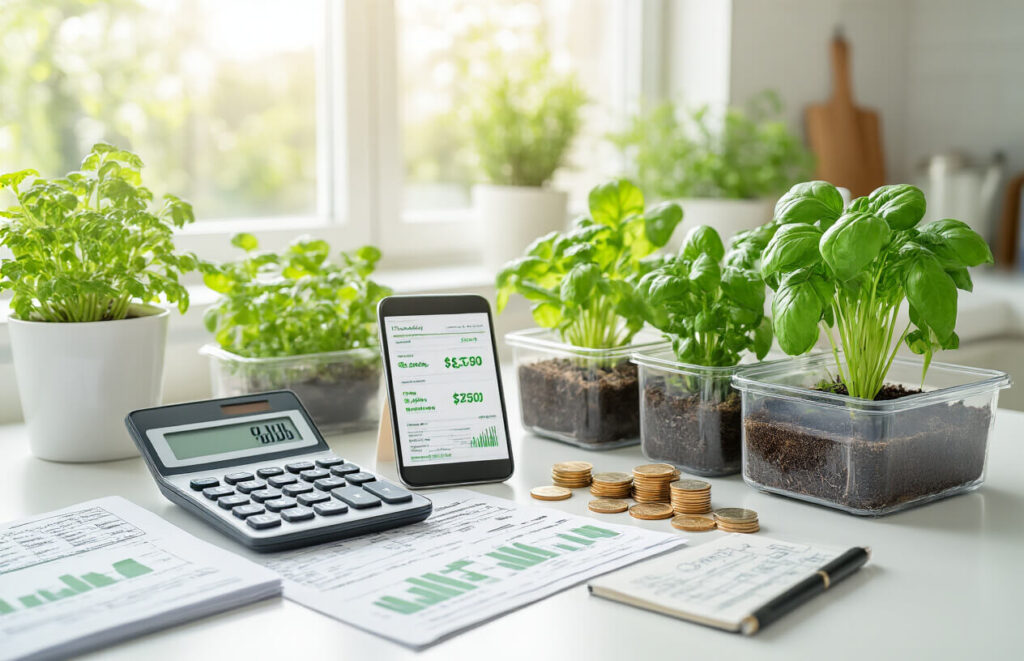
Initial Investment Breakdown and Equipment Costs
Setting up a hydroponic gardening system requires some upfront cash, but the numbers might surprise you. A basic starter system for countertop herbs runs about $50-100, while a mid-range setup that can handle leafy greens and cherry tomatoes costs between $200-500. Serious home growers looking at full-scale systems with multiple growing towers and automated features can expect to invest $800-1,500.
The core equipment includes growing containers, pumps, timers, growing medium, nutrients, pH testing kits, and grow lights if natural sunlight isn’t sufficient. LED grow lights represent the biggest single expense after the main system, typically running $100-300 for quality units that cover adequate growing space.
Ongoing Operational Expenses Versus Traditional Gardening
Monthly operational costs for hydroponic gardening average $15-40 per system, depending on size and plant selection. This covers electricity for pumps and lights, nutrients, pH adjusters, and replacement growing medium. Traditional soil gardening might seem cheaper initially, but hidden costs add up quickly.
Soil gardeners spend money on seeds, soil amendments, compost, fertilizers, pesticides, watering, and replacing plants lost to pests or diseases. Annual soil garden maintenance often reaches $100-200, not including the labor hours spent weeding, pest control, and soil preparation. Hydroponic systems eliminate many of these recurring expenses while delivering more consistent results.
Savings from Reduced Grocery Bills and Organic Produce
Fresh herbs from the grocery store cost $2-4 per small package and often wilt within days. A single hydroponic herb plant produces the equivalent of 10-15 store packages over its growing season. Organic lettuce and leafy greens, which can cost $4-6 per pound at retail, grow abundantly in hydroponic systems for pennies per serving.
Families growing their own cherry tomatoes, peppers, and herbs typically save $30-60 monthly on grocery bills. The quality difference is dramatic too – homegrown hydroponic produce stays fresh longer and tastes significantly better than store-bought alternatives that have traveled hundreds of miles and sat on shelves for days.
Return on Investment Timeline for Home Growers
Most home hydroponic gardening enthusiasts see their initial investment pay for itself within 8-18 months, depending on system size and what they choose to grow. Herb gardens typically break even fastest, often within 6-8 months, because fresh herbs command premium prices at stores.
Larger systems growing vegetables like tomatoes, peppers, and cucumbers take 12-18 months to reach break-even but generate substantial ongoing savings afterward. The investment timeline improves dramatically when you factor in the superior quality, freshness, and satisfaction of growing your own food year-round.
Common Challenges and Practical Solutions
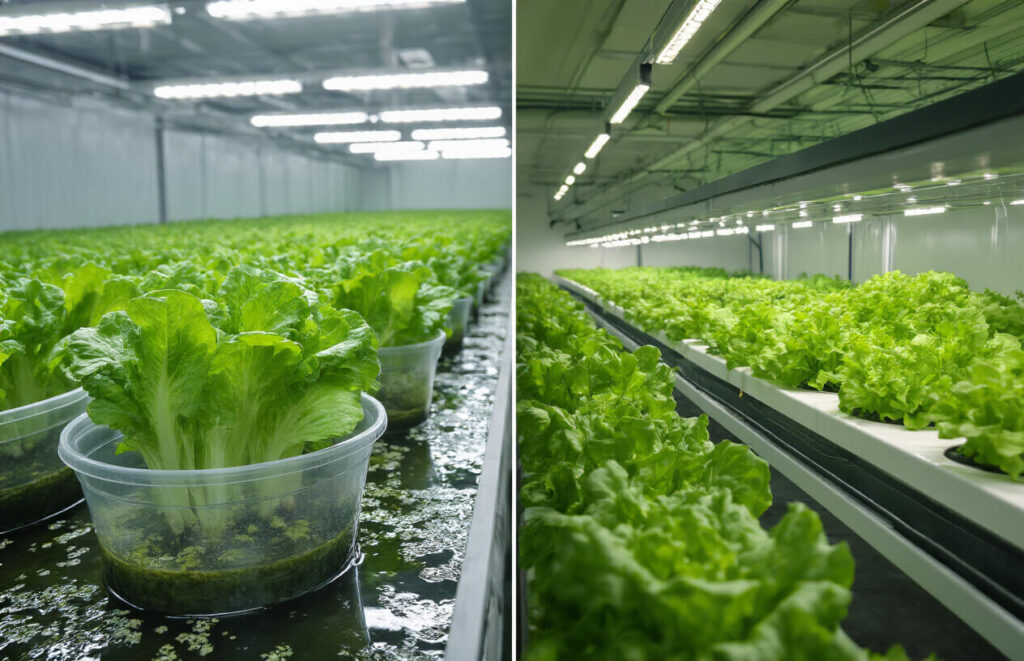
Managing pH levels and nutrient concentrations
Keeping your water at the right pH level feels like playing a balancing game at first, but it becomes second nature with practice. Most vegetables thrive in a slightly acidic environment between 5.5 and 6.5 pH. You’ll need a reliable pH meter – those cheap test strips from the hardware store won’t cut it for serious hydroponic gardening.
When your pH drifts too high, add phosphoric acid or specialized pH-down solutions drop by drop. If it’s too low, use potassium hydroxide or pH-up products. Never dump large amounts at once because dramatic swings stress your plants more than gradual adjustments.
Nutrient concentration requires equal attention. Your electrical conductivity (EC) meter tells you how much dissolved nutrients are in your water. Different growth stages demand different concentrations – seedlings need weaker solutions around 0.8-1.2 EC, while mature plants can handle 1.6-2.4 EC.
Watch for these warning signs: yellowing leaves often mean nitrogen deficiency, purple stems suggest phosphorus problems, and brown leaf edges indicate nutrient burn from over-concentration. Keep a feeding schedule and check levels every few days. Top off with plain water between nutrient changes since plants drink more water than they consume nutrients.
Preventing system failures and backup strategies
Power outages pose the biggest threat to your hydroponic setup. Without pumps circulating water, your plants can die within hours. Install an uninterruptible power supply (UPS) that keeps critical pumps running for at least 4-6 hours. For longer outages, a small generator or battery backup system becomes essential.
Water pumps fail more often than you’d expect. Keep spare pumps on hand and inspect them monthly for unusual noises or reduced flow. Clean pump filters regularly and replace them according to manufacturer schedules. If your primary pump dies, you can manually water your plants every few hours as an emergency measure.
Air pumps for deep water culture systems need redundancy too. Without oxygen in the root zone, plants suffocate quickly. Run dual air pumps or keep a backup ready to swap in. Battery-powered aquarium pumps work as temporary solutions during power failures.
Reservoir problems create cascading issues. Line your containers with food-grade materials to prevent cracks and leaks. Keep backup reservoirs filled with prepared nutrient solution. If algae takes over your main reservoir, having clean backup water lets you flush and restart the system immediately.
Temperature control failures during extreme weather can kill crops overnight. Monitor your growing area with wireless thermometers that alert your phone. Insulate reservoirs to buffer temperature swings, and consider backup heating or cooling methods for your climate.
Troubleshooting plant health issues without soil indicators
Reading plant health in hydroponic gardening requires different skills since you can’t rely on soil moisture or organic matter indicators. Your plants communicate through leaf color, growth patterns, and root appearance – you just need to learn their language.
Root inspection becomes your primary diagnostic tool. Healthy roots look white or cream-colored and feel firm. Brown, slimy, or foul-smelling roots signal root rot, often caused by poor oxygenation or contaminated water. Pull affected plants immediately and sterilize your system with hydrogen peroxide before replanting.
Leaf symptoms tell specific stories. Yellowing from bottom leaves upward usually means nitrogen deficiency or natural aging. Yellow leaves with green veins indicate iron deficiency, common when pH runs too high. Crispy brown edges suggest salt buildup or excessive nutrients, while soft brown spots might indicate bacterial infections.
Growth patterns reveal hidden problems. Stunted growth often points to root issues or improper pH preventing nutrient uptake. Leggy, stretched plants need stronger lighting. Wilting in well-watered systems suggests root problems or extreme temperatures.
Monitor new growth closely – it shows current conditions rather than past problems. Pale new leaves might indicate light deficiency or nutrient lockout. Dark green, thick leaves often mean too much nitrogen, while thin, pale growth suggests insufficient nutrients overall.
Check your water daily during the first month until you develop instincts for your system’s rhythms. Document problems with photos and notes to build your troubleshooting skills over time.
Maintenance requirements and time commitments
Daily maintenance takes about 10-15 minutes once your hydroponic gardening system runs smoothly. Check water levels, inspect plants for problems, and note any changes in growth or appearance. This quick morning routine prevents small issues from becoming major disasters.
Weekly tasks require 30-60 minutes depending on system size. Change nutrient solutions completely, clean reservoir tanks, and test pH and nutrient levels. Trim dead leaves, harvest ready produce, and clean pump filters. Wipe down surfaces to prevent algae buildup and check all equipment for proper operation.
Monthly deep cleaning protects long-term system health. Disassemble pumps for thorough cleaning, replace air stones in deep water culture systems, and sterilize all containers with diluted bleach solution. Inspect tubing for clogs or damage, clean grow lights, and calibrate pH and EC meters with fresh calibration solutions.
Seasonal maintenance varies by climate and growing cycles. Replace grow lights annually or when output drops noticeably. Service pumps according to manufacturer schedules, usually every 6-12 months. Deep clean entire systems between crop rotations to prevent disease carryover.
Time investments pay off quickly compared to traditional gardening. No weeding, minimal pest problems, and faster growth rates mean less total time per pound of produce. Most home growers spend 2-4 hours weekly maintaining systems that produce vegetables year-round.
Start small with simple systems like kratky method or basic deep water culture to minimize initial time commitments. As you gain experience and confidence, larger systems become manageable without overwhelming your schedule.
Best Plants for Hydroponic Home Growing
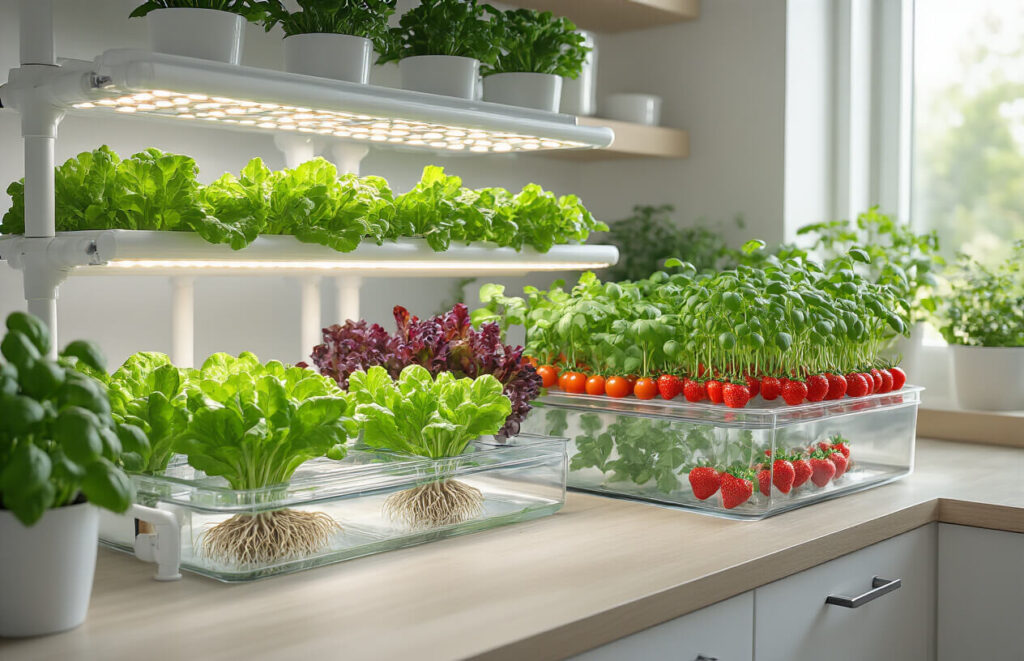
High-yield vegetables perfect for beginners
Leafy greens dominate the beginner-friendly category in hydroponic gardening, offering fast growth and forgiving growing conditions. Lettuce varieties like romaine, buttercrunch, and arugula flourish in hydroponic systems, typically reaching harvest-ready size in just 30-45 days. These plants adapt beautifully to nutrient film technique (NFT) or deep water culture systems.
Spinach ranks as another stellar choice, producing abundant harvests while tolerating slight nutrient fluctuations that beginners might encounter. Swiss chard delivers both beauty and nutrition, with its colorful stems adding visual appeal to your growing space while providing continuous leaf harvests for months.
Kale varieties, including curly and dinosaur kale, thrive in cooler hydroponic environments and offer incredible nutritional density per square foot. These hardy plants forgive minor pH swings and continue producing even when outer leaves are harvested regularly.
Bok choy and other Asian greens like mizuna and tatsoi grow exceptionally well in hydroponic setups, often outperforming their soil-grown counterparts by 40-50% in both speed and yield. Their shallow root systems make them perfect for smaller hydroponic systems.
Herbs that thrive in soilless environments
Basil stands as the crown jewel of hydroponic herb growing, with varieties like Genovese, purple, and Thai basil producing aromatic leaves continuously when grown in nutrient-rich water solutions. The controlled environment prevents common soil-borne diseases that plague traditional basil cultivation.
Cilantro and parsley grow remarkably well hydroponically, developing stronger flavors due to consistent nutrient delivery. These herbs typically grow 25% faster than soil-grown versions and maintain better leaf quality throughout their growing cycle.
Mint varieties absolutely love hydroponic environments, though their aggressive spreading nature becomes an advantage rather than a garden-takeover problem. Spearmint, peppermint, and chocolate mint varieties all perform exceptionally well, producing intense flavors perfect for teas, cocktails, and culinary applications.
Oregano, thyme, and rosemary adapt surprisingly well to hydroponic systems despite their Mediterranean origins. These woody herbs develop more concentrated essential oils when grown in controlled nutrient solutions, creating more flavorful harvests than many soil-grown alternatives.
Chives and green onions offer continuous harvesting opportunities, regrowing quickly after cutting and providing fresh flavor additions to meals throughout the growing season.
Fruiting plants with exceptional hydroponic performance
Tomatoes represent the holy grail of hydroponic fruiting plants, with cherry tomato varieties like ‘Sweet 100’ and ‘Sun Gold’ producing exceptional yields in home systems. Determinate varieties work best for beginners, while indeterminate types can produce for months with proper support systems.
Peppers, both sweet and hot varieties, excel in hydroponic environments where their root systems receive consistent moisture and nutrients. Bell peppers, jalapeños, and habaneros often produce larger, more flavorful fruits than their soil-grown counterparts when given adequate support and lighting.
Strawberries shine in hydroponic gardening, particularly day-neutral varieties that produce continuously rather than in single seasons. The clean growing environment eliminates many pest issues while producing sweeter, cleaner berries that don’t require washing before eating.
Cucumber varieties, especially bush or dwarf types, produce impressive yields in vertical hydroponic systems. Their high water content makes them naturally suited to water-based growing methods, often producing straighter, more uniform fruits than traditional soil cultivation.
| Plant Type | Days to Harvest | Difficulty Level | Yield Advantage |
|---|---|---|---|
| Lettuce | 30-45 | Beginner | 30-40% |
| Basil | 60-90 | Beginner | 25-35% |
| Cherry Tomatoes | 65-80 | Intermediate | 40-60% |
| Strawberries | 60-120 | Intermediate | 20-30% |
Conclusion
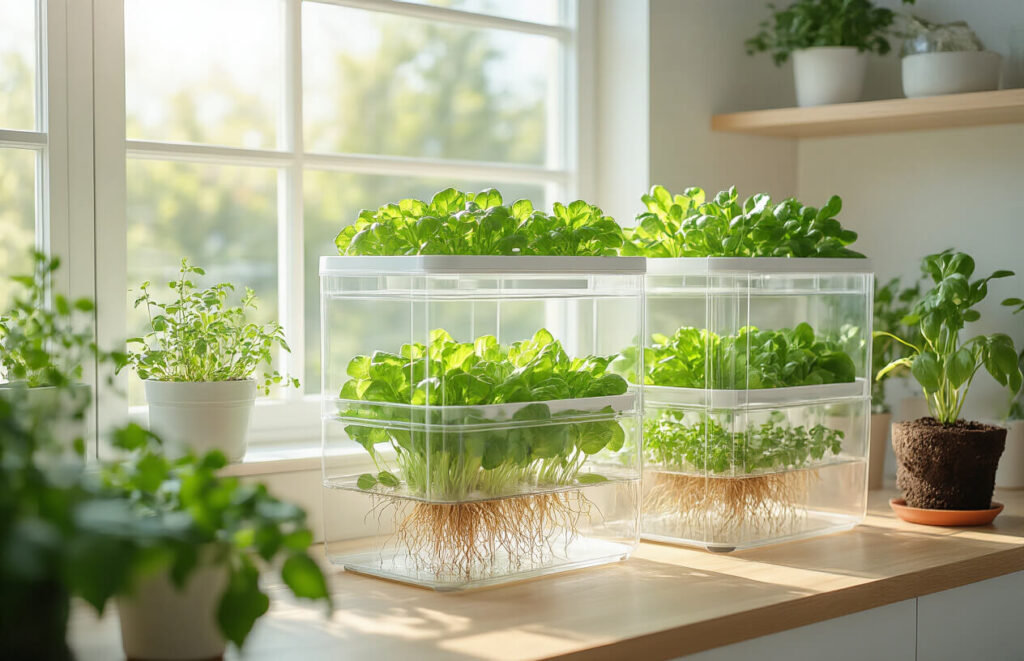
Growing food without soil might sound strange at first, but hydroponics offers some pretty amazing advantages that make traditional gardening look outdated. You get faster plant growth, better control over nutrients, and use way less water than regular gardening. Plus, you can grow fresh vegetables year-round right in your kitchen or basement, regardless of weather or soil quality outside.
Sure, there’s an upfront cost to get your hydroponic system running, and you’ll need to learn some new skills along the way. But once you get the hang of it, you’ll be harvesting crisp lettuce, juicy tomatoes, and fresh herbs much faster than your neighbors with their soil-based gardens. Start small with easy plants like lettuce or basil, and you’ll quickly see why so many people are ditching dirt for good. Your wallet, your taste buds, and the environment will thank you for making the switch.

